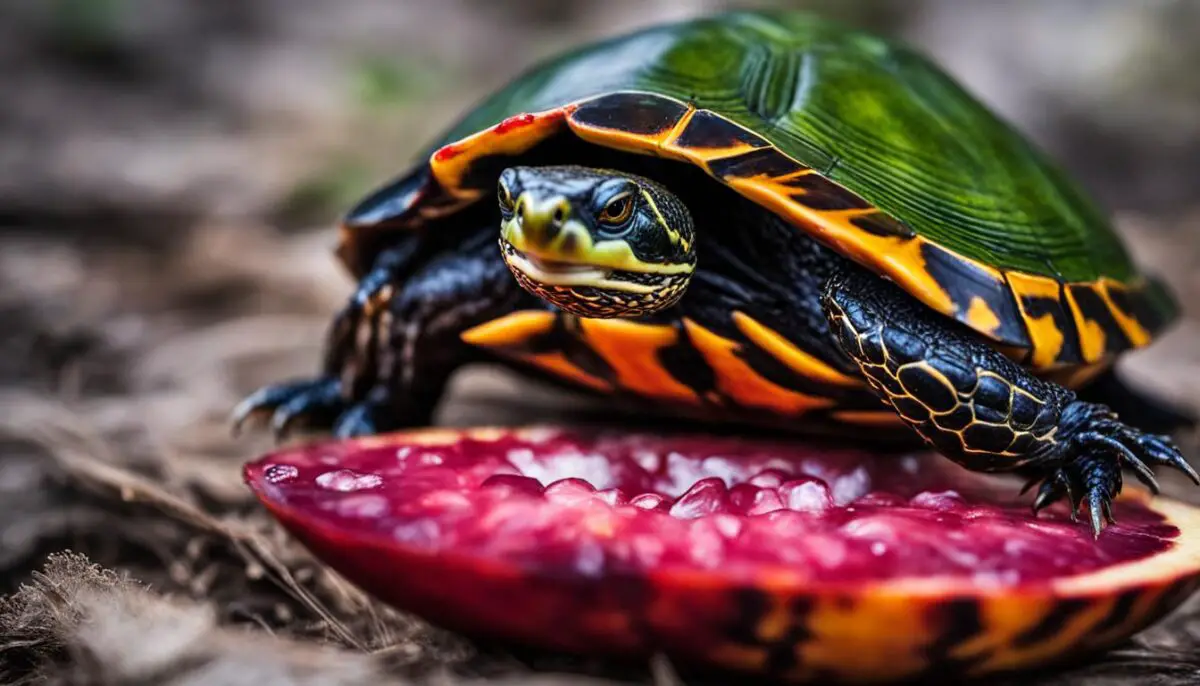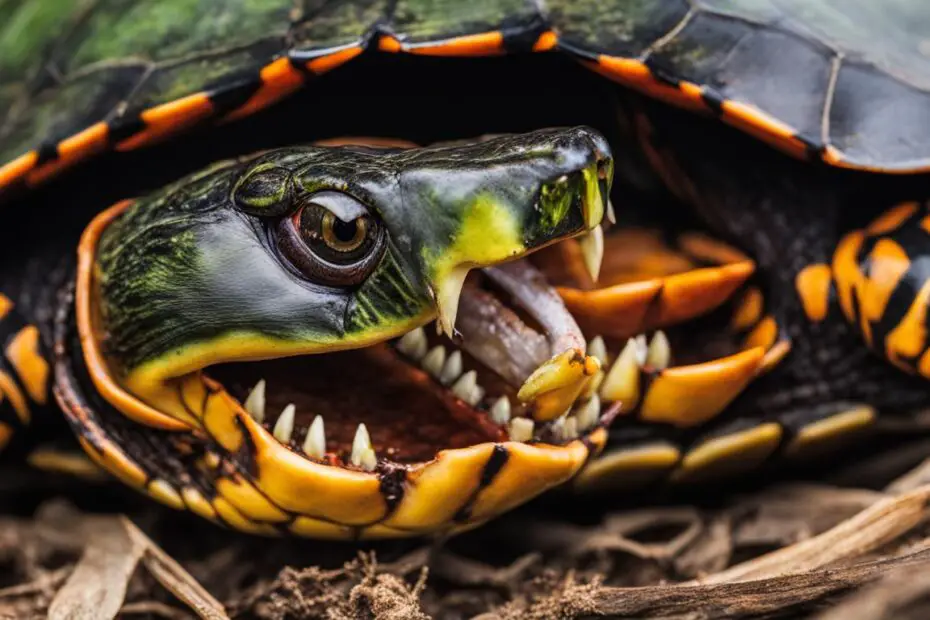Painted turtles are a fascinating species of turtles that are known for their vibrant colors and unique markings. They are commonly found in North America and are often kept as pets due to their striking appearance. However, many people have questions about their biting habits and aggression. In this article, we will explore the truth about painted turtles and provide insights into their behavior, as well as tips on how to interact safely with them.
Key Takeaways:
- Painted turtles are generally non-aggressive creatures and pose little to no threat to humans.
- While they can bite if they feel threatened or scared, practicing safe handling techniques can minimize the risk of being bitten.
- Understanding painted turtle behavior and giving them space is essential for safe interactions.
- Painted turtles can make great pets with proper care and attention to their specific needs.
- By respecting their space and treating them with care, we can enjoy the beauty of these captivating reptiles safely.
Understanding Painted Turtle Behavior
Painted turtles are fascinating creatures known for their docile nature and captivating behavior. Let’s explore their behavior in more detail.
Painted turtles spend the majority of their time in the water, where they gracefully swim and forage for food. They have a diverse diet that includes aquatic plants and small invertebrates, allowing them to thrive in their natural habitat.
During the mating season, male painted turtles may exhibit territorial behavior and become more aggressive towards other males. This aggression is primarily directed at other turtles and does not pose a threat to humans. It’s important to give these turtles space and observe them from a safe distance, allowing them to engage in their natural behaviors.
Female painted turtles, on the other hand, display nesting behavior during the spring and summer months. They dig holes in sandy soil or loose gravel to lay their eggs, ensuring the survival of future generations. Witnessing this nesting process can be a remarkable sight, but it’s important to avoid disturbing the turtles or their nesting sites.

As you can see, understanding painted turtle behavior is crucial for appreciating their natural instincts and ensuring their well-being. By observing these graceful creatures from a safe distance, we can marvel at their beauty without causing any harm.
Do Painted Turtles Bite Humans?
While it is rare for painted turtles to bite humans, they have the potential to do so if they feel threatened or scared. Painted turtles have a sharp beak, which they use to grip their food and defend themselves if necessary. If you handle a painted turtle improperly or try to grab it forcefully, it may bite as a defense mechanism. However, with proper handling and respect for their space, the risk of being bitten by a painted turtle is minimal. It is essential to remember that these turtles are not aggressive towards humans and will only bite if they perceive a threat.

Interacting Safely with Painted Turtles
To safely interact with painted turtles and avoid bites, it is crucial to follow a few guidelines. Firstly, it is essential to approach painted turtles calmly and quietly, as sudden movements or loud noises can startle them. When handling a painted turtle, make sure to support its body fully and avoid grabbing or squeezing it tightly. It is best to handle them gently and with respect, allowing them to move freely in your hands. Additionally, avoid touching or provoking their face, as this can provoke a defensive response. By treating painted turtles with care and caution, you can minimize the risk of bites and have a safe interaction with these fascinating creatures.
Remember, painted turtles are generally peaceful creatures and pose little to no threat to humans. They may only bite if they feel threatened or scared. By following the tips below on how to interact safely with painted turtles, you can enjoy their presence without the risk of getting bitten:
- Approach calmly and quietly: Avoid sudden movements or loud noises when approaching a painted turtle. This helps to prevent startling or agitating the turtle.
- Support their body: When handling a painted turtle, it is important to fully support its body. Avoid grabbing or squeezing it tightly, as this can cause stress or discomfort.
- Handle gently and with respect: Treat painted turtles with care and respect, allowing them to move freely in your hands. Avoid any rough or forceful handling.
- Avoid touching their face: Provoking a painted turtle’s face can trigger a defensive response and increase the risk of getting bitten. Respect their personal space and avoid any direct contact with their face.
By adhering to these guidelines, you can ensure a safe and enjoyable experience when interacting with painted turtles. Remember, these creatures have their own unique personalities, so always observe their behavior and adjust your approach accordingly. With proper techniques and a respectful attitude, you can have a wonderful time getting to know these fascinating reptiles.
“Treat painted turtles with care and caution, and they will reward you with their beauty and grace.” – ReptileExpert

Painted Turtles as Pets
Painted turtles can be wonderful pets for those who are responsible and knowledgeable about their care. Before bringing a painted turtle into your home, it is important to understand their specific care requirements to ensure their health and happiness.
Pet painted turtles require a well-maintained tank or enclosure that replicates their natural habitat. Here are some essential factors to consider when setting up a suitable turtle tank:
- Tank Size: Ensure that the turtle has enough space to move around comfortably. A general guideline is to provide 10 gallons of tank space per inch of turtle shell length.
- Water Quality: Maintain clean water in the tank to ensure the turtle’s health. Use a water conditioner to remove chlorine and other harmful chemicals from tap water.
- Lighting and Heating: Pet turtles require both UVA and UVB lighting for their overall well-being. UVB light helps with calcium metabolism, which is crucial for shell and bone development. Use a heat lamp and a basking area to provide warmth and simulate the sun’s rays.
Aside from appropriate tank setup, it is vital to provide painted turtles with a balanced and varied diet to meet their nutritional needs. A combination of commercially available turtle food and fresh vegetables can ensure their health and growth.
“Proper diet and habitat setup are the building blocks of a healthy and happy painted turtle.”
When interacting with pet painted turtles, it is important to handle them with care and respect to avoid stress or injury. While some turtles may tolerate handling to some extent, it is always best to observe their behavior and respond accordingly.
Fun Fact: Did you know that painted turtles can live up to 50 years in captivity?
Overall, with proper care, attention, and a suitable environment, painted turtles can thrive as pets and provide enjoyment to their owners for many years to come.
Image: Painted turtles can be great pets when provided with the right care and environment.
Conclusion
Painted turtles are fascinating reptiles that have captured the attention of many as pets. These peaceful creatures generally pose little to no threat to humans. While they have the potential to bite if they feel threatened or scared, it is important to practice safe handling and respect their space to avoid any incidents.
By understanding the behavior of painted turtles and providing them with proper care, you can enjoy their beauty and unique personalities. It is important to remember that each turtle has its own comfort level with human interaction. By observing and interacting with painted turtles with care and respect, you can further deepen your understanding of these captivating creatures.
Whether you choose to admire painted turtles in the wild or keep them as pets, their vibrant colors and graceful movements are sure to leave a lasting impression. With their fascinating behaviors and gentle nature, painted turtles offer an opportunity to connect with the natural world and appreciate the wonders of our ecosystem.
FAQ
Do painted turtles bite?
While painted turtles have the potential to bite if they feel threatened or scared, they are generally docile creatures and do not pose a significant risk to humans. With proper handling and respect for their space, the risk of being bitten by a painted turtle is minimal.
Are painted turtles aggressive?
Painted turtles are not typically aggressive towards humans. They may display territorial behavior during the mating season, but this aggression is limited to other turtles and does not pose a threat to humans.
How to avoid turtle bites?
To avoid being bitten by a painted turtle, approach them calmly and quietly. When handling a painted turtle, support its body fully, avoid grabbing or squeezing it tightly, and refrain from touching or provoking its face.
Can painted turtles bite humans?
While it is rare for painted turtles to bite humans, they have the potential to do so if they feel threatened or scared. It is important to handle them with care and respect to minimize the risk of bites.
What is the behavior of painted turtles?
Painted turtles are generally docile and spend most of their time in the water. They swim gracefully and feed on aquatic plants and small invertebrates. During the mating season, males may display territorial behavior, and females may exhibit nesting behavior.
Can I keep painted turtles as pets?
Painted turtles can make great pets for responsible and knowledgeable owners. However, it is important to understand their specific care requirements, including providing a well-maintained tank or enclosure, appropriate lighting, heating, a basking area, clean water, and a balanced diet.
How should I interact safely with painted turtles?
To interact safely with painted turtles, approach them calmly, support their body fully when handling, avoid sudden movements or loud noises, and treat them with care and respect. By following these guidelines, you can minimize the risk of bites and have a safe interaction with these fascinating reptiles.
What should I feed painted turtles?
Painted turtles should have a balanced diet that consists of both commercial turtle food and fresh vegetables. It is important to provide them with a varied and nutritious diet to ensure their health and well-being.
What are the care requirements for painted turtles as pets?
Pet painted turtles require a well-maintained tank or enclosure, appropriate lighting, heating, a basking area, clean water, and a balanced diet. It is essential to provide them with a suitable living environment to thrive as pets.

